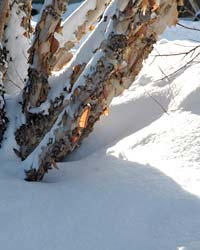Betula nigra
 A biting February morning in Chicago can be a challenging experience for anyone, but for a lover of trees, it can also turn into an exhilarating moment of truth. With the air crystalline cold and the winter sun rocketing off the white of the snow, all plants are revealed in their naked glory. This is a moment when you really love your birch.
A biting February morning in Chicago can be a challenging experience for anyone, but for a lover of trees, it can also turn into an exhilarating moment of truth. With the air crystalline cold and the winter sun rocketing off the white of the snow, all plants are revealed in their naked glory. This is a moment when you really love your birch.
But even if the following day is shrouded in gray and freezing drizzle has slickered your garden with ice — a day when even your faithful chickadees abandon the feeder — this, too, is a moment when you love your birch.
The members of the Betula genus are wonderful examples of trees that will delight no matter what the season. Winter accentuates the chalky white or cinnamon bark, often peeling, or "shingling," and calls attention to the dangling male flowers known as catkins. Spring is signaled by the limey-green new foliage, and much of the new woody growth displays an intensified color. During summer, the birch is in full glory with even the upright and pyramidal forms turning pendulous at their branch tips. In autumn, the serrated triangular leaves change from golden to orange or copper, depending on the species.
Many birches are native to northern and eastern ranges, with the exception of Betula nigra, the river birch. When taken from their preferred home (where the soil is moist, acidic, well-drained, and cool), and planted in the Midwest, (where soils are often heavy and alkaline, and hot, droughty summers dry out the moisture they favor), stress is bound to occur. With stress, insects and disease are quick to follow, most notably the bronze birch borer, leaf miner, and chlorosis. But if the recommended plants are sited and maintained properly, the birch will flourish as a tree for all seasons.
Betula nigra is the most southerly of all birches but still is one of the best choices as a landscape tree for our area. Able to withstand variations in soil moisture and composition, as well as hot Chicago summers, it is also the most borer resistant. Through the Chicagoland Grows® Plant Introduction Program, a collaboration with The Morton Arboretum and the Ornamental Growers Association of Northern Illinois, the ºÚÁϳԹÏÍø introduced a unique dwarf cultivar, Betula nigra 'Little King'. Available at nurseries as Fox Valley river birch, it can grows to 20 feet by 25 feet at maturity (compared with the standard 60 feet by 50 feet of the species). Dense twigginess and the sheen of its rosy-brown peeling bark are its most ornamental features. River birch is susceptible to chlorosis, as are most birches in our area, and proper siting for this tree should include a soil test to be sure the soil is acid enough.
'Little King' is touted as an excellent alternative to other intermediate-sized ornamental trees. It is useful as a specimen in limited space applications, although it will grow as wide as it grows tall. When provided with even moisture and an organic, acid soil, it will reward gardeners with its four-season appeal. If the leaves begin to lose their bright green color and turn chartreuse, compost, leaf mold or other natural soil amendments can be applied in late fall and again in early spring. Mulch the root zone of the tree and avoid underplanting it with annuals or grass, which will compete for the same water and nutrients.

